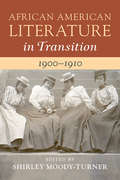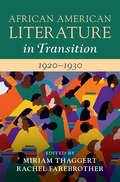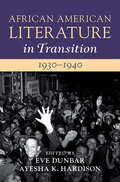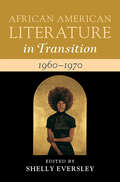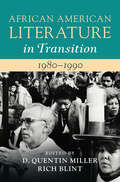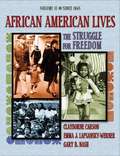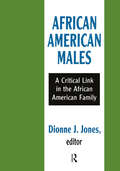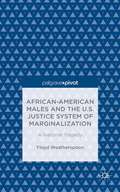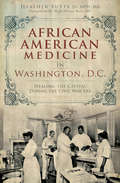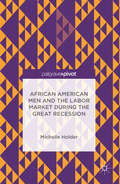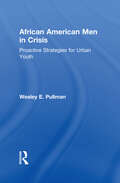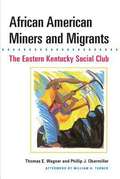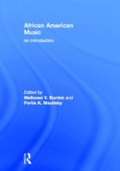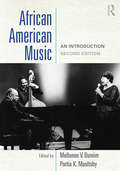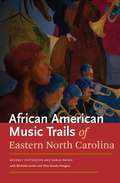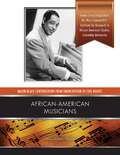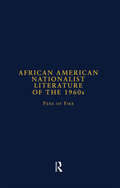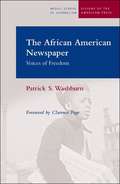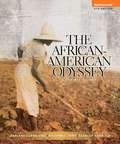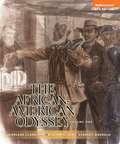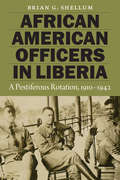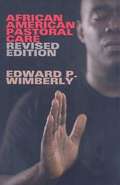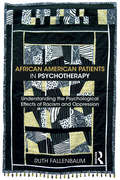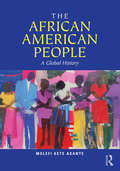- Table View
- List View
African American Literature in Transition, 1900–1910: Volume 7 (African American Literature in Transition)
by Shirley Moody-TurnerAfrican American Literature in Transition, 1900–1910 offers a wide ranging, multi-disciplinary approach to early twentieth century African American literature and culture. It showcases the literary and cultural productions that took shape in the critical years after Reconstruction, but before the Harlem Renaissance, the period known as the nadir of African American history. It undercovers the dynamic work being done by Black authors, painters, photographers, poets, editors, boxers, and entertainers to shape 'New Negro' identities and to chart a new path for a new century. The book is structured into four key areas: Black publishing and print culture; innovations in genre and form; the race, class and gender politics of literary and cultural production; and new geographies of Black literary history. These overarching themes, along with the introduction of established figures and movement, alongside lesser known texts and original research, offer a radical re-conceptualization of this critical, but understudied period in African American literary history.
African American Literature in Transition, 1920–1930: Volume 9 (African American Literature in Transition)
by Miriam Thaggert Rachel FarebrotherAfrican American Literature in Transition, 1920-1930 presents original essays that map ideological, historical, and cultural shifts in the 1920s. Complicating the familiar reading of the 1920s as a decade that began with a spectacular boom and ended with disillusionment and bust, the collection explores the range and diversity of Black cultural production. Emphasizing a generative contrast between the ephemeral qualities of periodicals, clothes, and décor and the relative fixity of canonical texts, this volume captures in its dynamics a cultural movement that was fluid and expansive. Chapters by leading scholars are grouped into four sections: 'Habitus, Sound, Fashion'; 'Spaces: Chronicles of Harlem and Beyond'; 'Uplift Renewed: Religion, Protest, and Education,' and 'Serial Reading: Magazines and Periodical Culture.'
African American Literature in Transition, 1930–1940: Volume 10 (African American Literature in Transition)
by Eve Dunbar Ayesha K. HardisonThe volume explores 1930s African American writing to examine Black life, culture, and politics to document the ways Black artists and everyday people managed the Great Depression's economic impact on the creative and the social. Essays engage iconic figures such as Sterling Brown, Langston Hughes, Zora Neale Hurston, Dorothy West, and Richard Wright as well as understudied writers such as Arna Bontemps and Marita Bonner, Henry Lee Moon, and Roi Ottley. This book demonstrates the significance of the New Deal's Works Progress Administration (WPA), the Communist Party of the United States (CPUSA) and Black literary circles in the absence of white patronage. By featuring novels, poetry, short fiction, and drama alongside guidebooks, photographs, and print culture, African American Literature in Transition 1930-1940 provides evidence of the literary culture created by Black writers and readers during a period of economic precarity, expanded activism for social justice, and urgent internationalism.
African American Literature in Transition, 1960–1970: Black Art, Politics, and Aesthetics (African American Literature in Transition)
by Shelly EversleyThis volume considers innovations, transitions, and traditions in both familiar and unfamiliar texts and moments in 1960s African American literature and culture. It interrogates declarations of race, authenticity, personal and collective empowerment, political action, and aesthetics within this key decade. It is divided into three sections. The first section engages poetry and music as pivotal cultural form in 1960s literary transitions. The second section explains how literature, culture, and politics intersect to offer a blueprint for revolution within and beyond the United States. The final section addresses literary and cultural moments that are lesser-known in the canon of African American literature and culture. This book presents the 1960s as a unique commitment to art, when 'Black' became a political identity, one in which racial social justice became inseparable from aesthetic practice.
African American Literature in Transition, 1980–1990: Volume 15 (African American Literature in Transition)
by D. Quentin Miller Rich BlintAfrican American Literature in Transition, 1980–1990 tracks Black expressive culture in the 1980s as novelists, poets, dramatists, filmmakers, and performers grappled with the contradictory legacies of the civil rights era, and the start of culture wars and policy machinations that would come to characterize the 1990s. The volume is necessarily interdisciplinary and critically promiscuous in its methodologies and objects of study as it reconsiders conventional temporal, spatial, and moral understandings of how African American letters emerged immediately after the movement James Baldwin describes as the 'latest slave rebellion.' As such, the question of the state of America's democratic project as refracted through the literature of the shaping presence of African Americans is one of the guiding concerns of this volume preoccupied with a moment in American literary history still burdened by the legacies of the 1960s, while imagining the contours of an African Americanist future in the new millennium.
African American Lives: The Struggle for Freedom Volume II
by Clayborne Carson Emma J. Lapsansky-Werner Gary B. Nash'African American Lives, American History' uses a biographical approach to present African Americans as active and thoughtful agents in the construction of their lives and communities. Each chapter opens with a vignette focusing on an individual involved in a dramatic moment or event. Personal stories are told throughout the narrative.
African American Males: A Critical Link in the African American Family
by Dionne J. JonesAfrican American families have demonstrated their strengths and survival skills through many generations, from slavery to the present time. As the African American middle class has grown over the last two decades, so have their numbers among elected officials and in business. Despite this, African Americans are experiencing extreme stress, but African American males appear to suffer the most. The disproportionate share of African American male inmates in the United States, the high homicidal rate, the astronomical rise and spread of the AIDS virus, and the continuing growth of drug abuse, all suggest that the African American male may be becoming an endangered species. In order to save the African American family. the structural and environmental conditions that give rise to these negative conditions must be studied. The chapters in this volume address some of the pressing issues affecting African American men. Chapters and contributors include: "Reaffirming Young African American Males: Mentoring and Community Involvement by Fraternities and Other Groups" by Dionne J. Jones. Victor E. Bibbins, and Ronald D. Henderson; "Health Status of African American Men" by Lawrence E. Gary; "Urban Adolescent Homicidal Violence: An Emerging Public Health Concern" by Ronald K. Barrett; and "Pastoral Counseling with African American Men" by Edward P. Wimberly. African American Males affirms that this segment of the population is a precious resource, and as such, they must be nurtured throughout their lives. The current situation makes for structural unbalance in American society as a whole, no less than within African American communities as such. This book will be of interest to sociologists, psychologists, and black studies specialists.
African-American Males and the U.S. Justice System of Marginalization: A National Tragedy
by Floyd WeatherspoonThis book provides an overview of the economic and social status of African-American males in America which continues to deteriorate at an alarming rate.
African American Medicine in Washington, D.C.: Healing the Capital During the Civil War Era
by Heather ButtsThe true story of the black doctors and nurses who tended to Civil War soldiers in the capital. Just as African Americans fought in defense of the Union during the Civil War, African American nurses, doctors, and surgeons worked to heal those soldiers. In the nation&’s capital, these brave healthcare workers created a medical infrastructure for African Americans, by African Americans. Preeminent surgeon Alexander T. Augusta fought discrimination, visited President Lincoln, testified before Congress, and aided the war effort. Washington&’s Freedmen&’s Hospital was formed to serve the District&’s growing free African American population, eventually becoming the Howard University Medical Center. These physicians would form the National Medical Association, the largest and oldest organization representing African American doctors and patients. This book recounts the heroic lives and work of Washington&’s African American medical community during the Civil War.
African American Men and the Labor Market during the Great Recession
by Michelle HolderThis book analyzes the status and position of African American men in the U.S. labor market prior to, during, and after the Great Recession. Using a model of occupational crowding, the book outlines how the representation of African American men in major occupational categories almost universally declined during the recent recession even as white non-Hispanic men were able to maintain their occupational representation in the face of staggering job losses. Using US Census Bureau data, this book illustrates how African American men sought to insulate their group from devastating job losses by increasing their educational attainment in a job market where employers exercised more leverage in hiring. However, this strategy was unable to protect this group from disparate job losses as African American men became further marginalized in the workforce during the Great Recession. Policy approaches to address high African American male unemployment are outlined in the final chapter.
African American Men in Crisis: Proactive Strategies for Urban Youth (Children of Poverty)
by Wesley E. PullmanFirst published in 1995. Routledge is an imprint of Taylor & Francis, an informa company.
African American Miners and Migrants: THE EASTERN KENTUCKY SOCIAL CLUB
by Thomas E. Wagner Philip J. ObermillerThomas E. Wagner and Phillip J. Obermiller's African American Miners and Migrants documents the lives of Eastern Kentucky Social Club (EKSC) members, a group of black Appalachians who left the eastern Kentucky coalfields and their coal company hometowns in Harlan County. Bound together by segregation, the inherent dangers of mining, and coal company paternalism, it might seem that black miners and mountaineers would be eager to forget their past. Instead, members of the EKSC have chosen to celebrate their Harlan County roots. African American Miners and Migrants uses historical and archival research and extensive personal interviews to explore their reasons and the ties that still bind them to eastern Kentucky. The book also examines life in the model coal towns of Benham and Lynch in the context of Progressive Era policies, the practice of welfare capitalism, and the contemporary national trend of building corporate towns and planned communities.
African American Music: An Introduction
by Mellonee Burnim Portia K. MaultsbyAfrican American Music: An Introduction is a collection of thirty essays by leading scholars which survey major African American musical genres, both sacred and secular, from slavery to the present. It is the most comprehensive study of African American music currently available, with sixteen essays on major genres of African American music, as well as lengthy sections on the music industry, gender, and music as resistance. The work brings together, in a single volume, treatments of African American music that have existed largely independent of each other. The research is based in large part on ethnographic fieldwork, which privileges the voices of the music-makers themselves, while interpreting their narratives through a richly textured mosaic of history and culture. The book is replete with references to seminal recordings and recording artists, musical transcriptions, photographs, and illustrations that bring the music to life as expressions of human beings.
African American Music: An Introduction
by Portia K. Maultsby Mellonee V. BurnimAmerican Music: An Introduction, Second Edition is a collection of seventeen essays surveying major African American musical genres, both sacred and secular, from slavery to the present. With contributions by leading scholars in the field, the work brings together analyses of African American music based on ethnographic fieldwork, which privileges the voices of the music-makers themselves, woven into a richly textured mosaic of history and culture. At the same time, it incorporates musical treatments that bring clarity to the structural, melodic, and rhythmic characteristics that both distinguish and unify African American music. The second edition has been substantially revised and updated, and includes new essays on African and African American musical continuities, African-derived instrument construction and performance practice, techno, and quartet traditions. Musical transcriptions, photographs, illustrations, and a new audio CD bring the music to life.
African American Music Trails of Eastern North Carolina
by Sarah Bryan Beverly Patterson Michelle LanierThelonius Monk, Billy Taylor, and Maceo Parker--famous jazz artists who have shared the unique sounds of North Carolina with the world--are but a few of the dynamic African American artists from eastern North Carolina featured in The African American Music Trails of Eastern North Carolina. This first-of-its-kind travel guide will take you on a fascinating journey to music venues, events, and museums that illuminate the lives of the musicians and reveal the deep ties between music and community. Interviews with more than 90 artists open doors to a world of music, especially jazz, rhythm and blues, funk, gospel and church music, blues, rap, marching band music, and beach music. New and historical photographs enliven the narrative, and maps and travel information help you plan your trip. Included is a CD with 17 recordings performed by some of the region's outstanding artists.
African American Musicians (Major Black Contributions from Emancipat)
by Claudette HegelAfrican Americans--famous and anonymous alike--have helped shape popular musical genres ranging from jazz and blues to rock 'n' roll and rap. This book provides a vivid account of that process, beginning with the work songs and spirituals of slaves and continuing up to the present. African-American Musicians tells the stories of figures such as bluesman Robert Johnson, whose guitar playing was so extraordinary that people said he must have made a deal with the devil; jazz great Duke Ellington, considered one of America's greatest composers and bandleaders; classical singer Marian Anderson, who struck a blow for civil rights with her music; Michael Jackson, the "King of Pop"; and many, many more.
African American Nationalist Literature of the 1960s: Pens of Fire (Studies in American Popular History and Culture)
by Sandra Hollin FlowersBringing together political theory and literary works, this study recreates the political climate which made the 1960s an unforgettable era for young black Americans. A chapter on "The Many Shades of Black Nationalism," for instance, explains: why black nationalism is known by more than a dozen different names; how events in Africa influenced black nationalism in America; why Malcolm X's death had a greater impact on nationalism than did his life; and how the United States government unwittingly became nationalism's ally. Another chapter explores the bitter feud between the dominant factions of the 1960s-cultural and revolutionary nationalists. This feud erupted in both verbal and armed warfare and generated an abundance of political theory and literary works, much of which is out of circulation but is examined in the study. Nationalist poetry, theater, and fiction are each treated in separate chapters which exemplify the aesthetic and political concerns of this memorable period in American history and letters. Aside from its unique combination of artistic and political works, what makes this book important is the current revival of nationalist sentiment in African American life and arts. Though this revival is closely identified with the nationalism of the 1960s, it lacks the focus of that period. This study explains what gave the nationalism of the 1960s its focus, how that focus was expressed in art forms, and why 1960s nationalism continues to influence the African American identity and will probably do so well into the twenty-first century.
The African American Newspaper: Voice of Freedom (Visions of the American Press)
by Patrick WashburnIn March of 1827 the nation's first black newspaper appeared in New York City--to counter attacks on blacks by the city's other papers. From this signal event, The African American Newspaper traces the evolution of the black newspaper--and its ultimate decline--for more than 160 years until the end of the twentieth century. <p><p> The book chronicles the growth of the black press into a powerful and effective national voice for African Americans during the period from 1910 to 1950--a period that proved critical to the formation and gathering strength of the civil rights movement that emerged so forcefully in the following decades. In particular, author Patrick S. Washburn explores how the Pittsburgh Courier and the Chicago Defender led the way as the two most influential black newspapers in U.S. history, effectively setting the stage for the civil rights movement's successes. Washburn also examines the numerous reasons for the enormous decline of black newspapers in influence and circulation in the decades immediately following World War II. His book documents as never before how the press's singular accomplishments provide a unique record of all areas of black history and a significant and shaping affect on the black experience in America.
The African-American Odyssey
by Darlene Clark Hine William C. Hine Stanley C. HarroldA compelling story of agency, survival, struggle and triumph over adversity More than any other text, The African-American Odyssey illuminates the central place of African-Americans in U. S. history by telling the story of what it has meant to be black in America and how African-American history is inseparably woven into the greater context of American history. From Africa to the 21st century, this book follows the long and turbulent journey of African-Americans, the rich culture they have nurtured throughout their history and the quest for freedom through which African-Americans have sought to counter oppression and racism. This text also recognizes the diversity within the African-American sphere, providing coverage of class and gender and balancing the lives of ordinary men and women with accounts of black leaders and the impact each has had on the struggle for freedom.
The African-American Odyssey Volume 1
by Darlene Clark Hine Stanley Harrold William Clark HineA compelling story of agency, survival, struggle and triumph over adversity More than any other text, The African-American Odyssey illuminates the central place of African-Americans in U. S. history by telling the story of what it has meant to be black in America and how African-American history is inseparably woven into the greater context of American history. From Africa to the 21st century, this book follows the long and turbulent journey of African-Americans, the rich culture they have nurtured throughout their history and the quest for freedom through which African-Americans have sought to counter oppression and racism. This text also recognizes the diversity within the African-American sphere, providing coverage of class and gender and balancing the lives of ordinary men and women with accounts of black leaders and the impact each has had on the struggle for freedom.
African American Officers in Liberia: A Pestiferous Rotation, 1910–1942
by Brian G. ShellumAfrican American Officers in Liberia tells the story of seventeen African American officers who trained, reorganized, and commanded the Liberian Frontier Force from 1910 to 1942. In this West African country founded by freed black American slaves, African American officers performed their duties as instruments of imperialism for a country that was, at best, ambivalent about having them serve under arms at home and abroad. The United States extended its newfound imperial reach and policy of “Dollar Diplomacy” to Liberia, a country it considered a U.S. protectorate. Brian G. Shellum explores U.S. foreign policy toward Liberia and the African American diaspora, while detailing the African American military experience in the first half of the twentieth century. Shellum brings to life the story of the African American officers who carried out a dangerous mission in Liberia for an American government that did not treat them as equal citizens in their homeland, and he provides recognition for their critical role in preserving the independence of Liberia.
African American Pastoral Care: Revised Edition
by Edward P. WimberlyRespond to God's unfolding drama to bring healing and reconciliation. In this major revision of his classic book, Dr. Edward Wimberly updates his narrative methodology by examining current issues in African American pastoral care and counseling.
African American Pastoral Care and Counseling: The Politics of Oppression and Empowerment
by Edward P. WimberlyAll of these iterations of modern faith seem errant and in need of correction. African American Pastoral Care and Counseling may be just what we needed at this hour in history.
African American Patients in Psychotherapy: Understanding the Psychological Effects of Racism and Oppression
by Ruth FallenbaumAfrican American Patients in Psychotherapy integrates history, current events, arts, psychoanalytic thinking, and case studies to provide a model for understanding the social and historical dimensions of psychological development across African American communities. Among the topics included are psychological consequences of slavery and Jim Crow, the black patient and the white therapist, the toll of even “small” racist enactments, the black patient’s uneasy relationship with health care providers, and a revisiting of the idea of “black rage.” Author Ruth Fallenbaum also examines the psychological potential of reparation for centuries of slave labor and legalized wage and property theft.
The African American People: A Global History
by Molefi Kete AsanteThe African American People is the first history of the African American people to take a global look at the role African Americans have played in the world. Author Molefi Kete Asante synthesizes the familiar tale of history's effect on the African people who found themselves forcibly part of the United States with a new look at how African Americans in later generations impacted the rest of the world. Designed for a range of students studying African American History or African American Studies, The African American People takes the story from Africa to the Americas, and follows the diaspora through the Underground Railroad to Canada, and on to Europe, Asia, and around the globe. Including over 50 images documenting African American lives, The African American People presents the most detailed discussion of the African and African American diaspora to date, giving student the foundation they need to broaden their conception of African American History.
